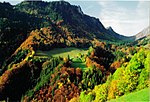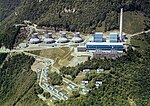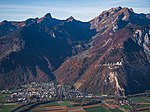Tauredunum event

The Tauredunum event (German: Tauredunum-Ereignis) of 563 AD was a tsunami on Lake Geneva (then under the Frankish territory of the Kingdom of Orleans), triggered by a massive landslide which caused widespread devastation and loss of life along the lakeshore. According to two contemporary chroniclers, the disaster was caused by the collapse of a mountainside at a place called Tauredunum at the eastern end of Lake Geneva. It caused a great wave to sweep the length of the lake, sweeping away villages on the shoreline and striking the city of Geneva with such force that it washed over the city walls and killed many of the inhabitants. A study published in October 2012 suggests that the Tauredunum landslide triggered the collapse of sediments that had accumulated at the point where the River Rhône flows into Lake Geneva. This caused a huge underwater mudslide that displaced several hundred million cubic metres of sediment, producing a tsunami up to 16 metres (52 ft) high that reached Geneva within about 70 minutes. There is evidence of four previous mudslides, suggesting that tsunamis may be a recurrent phenomenon on Lake Geneva. It is also speculated that such an event could happen again, with far more severe consequences as more people live within potentially affected areas, and because most people are not accustomed to the idea of tsunamis happening in landlocked bodies of water and are thus unaware of the danger.
Excerpt from the Wikipedia article Tauredunum event (License: CC BY-SA 3.0, Authors, Images).Tauredunum event
Port-Valais
Geographical coordinates (GPS) Address Nearby Places Show on map
Geographical coordinates (GPS)
| Latitude | Longitude |
|---|---|
| N 46.3575 ° | E 6.8519444444444 ° |
Address
1897 Port-Valais
Wallis, Switzerland
Open on Google Maps










